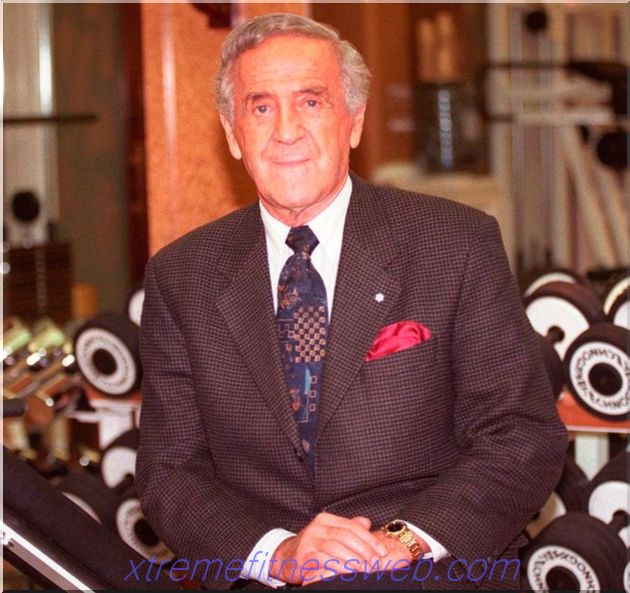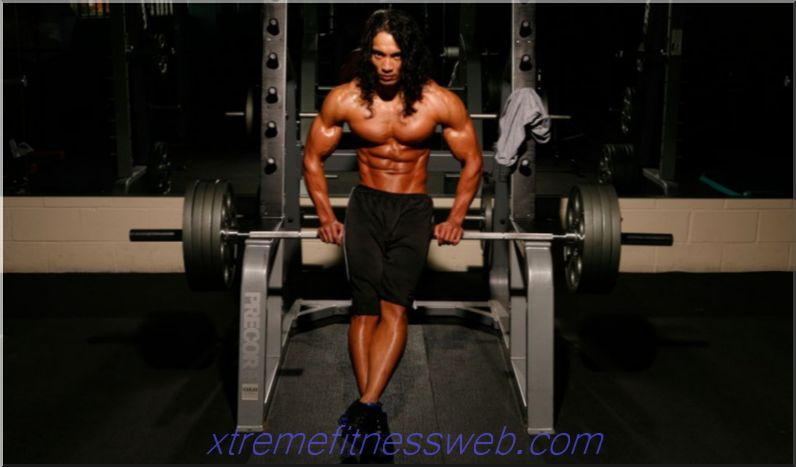
Plie with a dumbbell is often called a "female squat" and is given exclusively for the "buttocks." It is worth knowing that this is also one of the important supporting exercises to improve the stall speed in deadlift. And if the dumbbell is heavy enough, the movement ceases to be “feminine”. Yes, plie also has a more complex variety - squat “in depth” from skirtings or boxes with a weight attached to the belt. In addition to the buttocks, the movement uses the abs and long back muscles. And of course, the hip flexors and extensors also work, no matter what the fitness guru says for the sake of marketing.
Content
- 1 Technique
- 2 Recommendations
- 3 Options
- 4 Analysis of exercises
- 4.1 What muscles work
- 4.2 Preparing for exercise
- 4.3 Difference of Plie from Sumo Squat
- 4.4 Recommendations for implementation
- 5 Inclusion in training
Execution technique

Starting position
- For the squat, you have to stand on a step platform, stand or stack of pancakes. In most people, bending the knee in the amplitude characteristic of squats will be accompanied by a dumbbell hit on the ground;
- For dumbbells, you can stay on the floor. This movement is often mistakenly called a squat, but it is in it that the back is more inclined, due to which part of the length of the legs “hides”;
- The dumbbell is taken by the hands with the wheels, it is advisable not to keep the weight at your fingertips;
- The back is held straight, the shoulder blades are reduced;
- Setting the feet - heels slightly wider than the shoulders. Standing in a “twine” if you cannot squat down parallel to the hips with the floor is pointless;
- With one movement, the knees unbend and the athlete gets up
Traffic
- From a standing position, the dumbbell drops to the floor until it touches and rises;
- First, the athlete spreads his knees in the direction of his socks and begins to bend them;
- Then - as if "removes" the pelvis under itself and falls;
- The goal - the pelvic bones should fall into the plane of the knees or slightly lower;
- You can hold your back vertically only if it is comfortable and does not cause pain in the hip joint
Recommendations
- The knees may extend over the socks if the person’s thigh is significantly longer than the lower leg. This is not harmful and not dangerous, especially when you consider that with ordinary grays, for example, on a chair, they always go out of their socks;
- It is more important to press the heels to the floor and not tear them off during the exercise;
- Hands should be relaxed, the dumbbell should not hang in bent arms;
- The movement does not begin with the “pull” of the pelvis back, but with the bending of the knees. This is the only way to get the anatomically correct direction of movement.
Execution Options

- Exercise can be performed with a kettlebell, this will provide ease of retention and grip;
- The squeeze in the well also belongs to the versions of plie with a dumbbell, it anatomically resembles a squat-plie, but allows you to make a deeper gray;
- Advanced customers replace this movement with the pull of two dumbbells in the sumo or the pull of the bar in the sumo.
Parsing exercise
What muscles work

The main drivers in the exercise are the entire buttock, quadriceps, and thigh biceps. The biceps of the thighs and buttocks are included priority. The long back muscle also works; to say that the back does not work here is impossible.
How the stabilizers work the latissimus and the abdominal muscles. During the grip, the hands and muscles of the forearm are involved.
Exercise Preparation
Beginners can start with an anatomically convenient arrangement of the feet. There is no need to immediately “stand up in the splits” and try to squat something in this position. This usually results in inflammation of the hip joint, and discomfort in the lower back.
Stretching is important, but you won’t be able to “pull” yourself into the correct starting position. Therefore, it is recommended that you simply do the exercise and “pre-stretch” in a dynamic manner.
Typically, this movement is the first or second in terms of a beginner, so preliminarily performed MFR, cardio warm-up, joint warm-up, and a couple of approaches without burdening or with minimal weight.
Difference Plie from Sumo Squat

In fact, there is only one difference - in the position of the back. In both cases, in fitness (not bodybuilding, not powerlifting, but in physical education for health), it is better to place your feet at the width that is convenient for comfortable lowering in the gray.
The movement in both cases looks like this:
- In sumo, it begins with bending and raising the knees, but the pelvis drops down and is retracted a little back due to the inclination of the back. It is not necessary to specially stretch the pelvis back, especially at the start, this will lead to insufficient stretching of the gluteal muscles;
- In pli, the back is almost vertically straight. It is more convenient for beginners to hold a shell on their chest or to learn to squat with arms crossed on their shoulders.
Implementation Recommendations

Squat with a dumbbell is suitable for both beginners and experienced. If the exercise does not allow you to achieve the desired amplitude, it is recommended to use a more classic setting of the feet and cup squat.
Movement is best studied without weight, adding a dumbbell to the toast of technical skill.
The exercise is technically quite complicated, so if you can’t just do the plie with a dumbbell in your hands, you can do a cup squat or sit on a box with a truncated amplitude until the hip joints get used to working.
Technical nuances are as follows:
- The movement begins like any squat, with the knees apart with the toes pointing;
- Socks need to be kept to the sides, but at such a width that it is convenient for you;
- The back is kept straight, but the lower back may be slightly arched;
- Rounding shoulders forward allowed
Inclusion in training
Exercise can be the first or second in training beginners' legs, or the third, if we are talking about training with an emphasis on the development of strength indicators in deadlift.
It is usually performed in a medium repeat mode for 10-12 repetitions, but can also be performed in a larger number of repetitions. The mode of operation depends on the program; usually it does not make sense to include this movement in the plan more than once a week.







